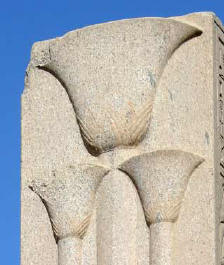| ```` |
Ancient
Egypt by Sjef Willockx |
||||||||||||||||||||||||||||||||||||||||
|
The hieroglyphic script drew for its characters on objects of daily life. With a plant so abundant in Egypt as papyrus, or one so pretty as the lotus, we need not be surprised to find these too among the hieroglyphs.
Papyrus’s incorporation
into the script was greatly facilitated by the fact that the Egyptian
artists managed to develop a graceful, yet simple outline for the
papyrus flower. Looking back at the photographs of the actual papyrus
plant that we’ve just seen, we must admit that this was no small feat.
The problem with this flower is, that it does not have an
outline. Egyptian pictorial art however heavily relied for its effectiveness on the use of shape's outlines - so where really none
existed, an outline had to be invented. (Several other stylizings of both the papyrus flower and its buds were used for papyrus columns: see the Visual Story about Columns & Pillars, elsewhere on this site). The following are the most frequently used papyrus hieroglyphs:
As you can see, two of these three (M15 and M16) were
(also) in use as determinative for the Delta region, or Lower Egypt.
(The flowers of M8 are modeled on the white lotus, those of M9 on the blue lotus. ) So unlike papyrus for Lower Egypt, the lotus was in the script not used to refer to Upper Egypt. Instead, Upper Egypt is in the script associated with the following signs:
*): Or more accurately: “He of the sedge and the bee”.
When we turn to the evidence of the earliest phase of
the script (dynasties 1 and 2), we find very few (possible) lotus signs
(see
IÄF-III
134, 188 and 201), and those few seem to be
related to Lower Egypt, not Upper Egypt. In the meantime, we have a brand-new plant to check out.
Back to start Previous Next Thumbnails
|
|
||||||||||||||||||||||||||||||||||||||||
|
|
All materials on this site are protected by copyright. All copyright by Sjef Willockx, unless otherwise indicated. |


